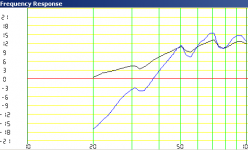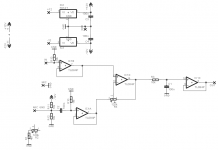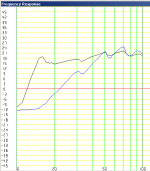I wasn't able to turn up anything in searching, however if this info exists already please point me to it.
could I mount a microphone to the front of my subwoofer and use that for feedback? The voltage input should be proportional to the acoustic output. Also, Is it true that most microphones are fairly accurate in the low range but it takes a decent one to measure high frequencies? So perhaps I could use an inexpensive eletret mic, amplify it, then use an opamp to compare the input and acoustical output, and then adjust accordingly. Maybe also put a low pass filter on this effect to place the feedback below any room modes.
Thanks
could I mount a microphone to the front of my subwoofer and use that for feedback? The voltage input should be proportional to the acoustic output. Also, Is it true that most microphones are fairly accurate in the low range but it takes a decent one to measure high frequencies? So perhaps I could use an inexpensive eletret mic, amplify it, then use an opamp to compare the input and acoustical output, and then adjust accordingly. Maybe also put a low pass filter on this effect to place the feedback below any room modes.
Thanks
Meyer Sound used to have a studio monitor that used a mic for feedback. I believe it (mic) was mounted in front of the woofer. I don't see it advertised on their website now(????). This aproach might not work so well on shorter wavelengths (tweeter). I think your largest distortion contribution will be from the woofers
I found the link: http://www.meyersound.com/products/studioseries/x-10/
I found the link: http://www.meyersound.com/products/studioseries/x-10/
I've never done this, but I have thought about it in the past as a way to avoid purchasing an accelerometer. Accelerometers are starting to get cheaper, but they are usually SMD, so more difficult to work with.
If you try this, it would probably be best to use a sealed box and a microphone inside the enclosure. It would then work at low frequencies where the enclosure is non-resonant. Make sure it is an omni mic.
If you try this, it would probably be best to use a sealed box and a microphone inside the enclosure. It would then work at low frequencies where the enclosure is non-resonant. Make sure it is an omni mic.
I like the accelerometer idea too!! Velodyne does that on their upper end subs. I think a thing to watch out for is cone modes. If the accelerometer is placed in the wrong spot, the FB info will be out of phase and the thing may bust into oscillation. You could probably test drive the accelerometer in a couple of location and make a phase plot.
I am planning to try this out, I already glued a microphone on my subwoofer and the measurements look very good, it's about the same as winisd calculated, including the phase.
If you want to look at it on the scope use something like a 5 volts power supply and a 4k7 resistor in series with the mic.
Be sure not to wire the mic reversed or you won't get any measurements
Also, you will need a lowpass, use a first order after the differential stage, not on the microphone signal or you might get lots of noise and a rising top end, something you don't want on a subwoofer.
If you want to look at it on the scope use something like a 5 volts power supply and a 4k7 resistor in series with the mic.
Be sure not to wire the mic reversed or you won't get any measurements

Also, you will need a lowpass, use a first order after the differential stage, not on the microphone signal or you might get lots of noise and a rising top end, something you don't want on a subwoofer.
In his book, in french, available free on the net at
http://www.brouchier.com/livre/index.html
or
http://www.brouchier.com/Le_son/LE_LIVRE.pdf
author Francis Brouchier has proposed to use a tweeter or a closed back (or closed front...) little loudspeaker as a pressure sensing low cost device and to place it inside the enclosure. An experimental easy setup.
Such a technique has been criticised by John Watkinson in one of his Electronics World articles however I think his arguments are valid only at high sound levels.
http://www.brouchier.com/livre/index.html
or
http://www.brouchier.com/Le_son/LE_LIVRE.pdf
author Francis Brouchier has proposed to use a tweeter or a closed back (or closed front...) little loudspeaker as a pressure sensing low cost device and to place it inside the enclosure. An experimental easy setup.
Such a technique has been criticised by John Watkinson in one of his Electronics World articles however I think his arguments are valid only at high sound levels.
Ron E said:I've never done this, but I have thought about it in the past as a way to avoid purchasing an accelerometer. Accelerometers are starting to get cheaper, but they are usually SMD, so more difficult to work with.
If you try this, it would probably be best to use a sealed box and a microphone inside the enclosure. It would then work at low frequencies where the enclosure is non-resonant. Make sure it is an omni mic.
Ah, but if the mic is placed inside the box, one would have to differentiate the signal twice to use it in a feedback loop. There is a difference of 12 dB/oct between the pressures inside and outside of a box at low frequencies.
The accelerometer is IMHO better, since it needs no differentiation, but still is as immune to "other" sounds on the outside as the in-the-box microphone placement.
...but the mic-in-the box version would work for BR enclosures too.
Feedback for BR enclosures is absolutely useless, first the sound from the bass reflex pipe is 180 degrees out of phase which makes it very very hard to get good feedback, second a bass reflex is a resonator, which means the sound builds up slow when signal is applied and decays slow when the signal is turned off.
This means the feedback circuit will applie huge amounts of power at the beginning to get the resonance started and it will apply huge amounts of power at the end to stop the resonance.
You might as well just plug up the pipe and use it as a sealed enclosure.
This means the feedback circuit will applie huge amounts of power at the beginning to get the resonance started and it will apply huge amounts of power at the end to stop the resonance.
You might as well just plug up the pipe and use it as a sealed enclosure.
Hi,
Mics could be used for bass applications up to app. 500Hz
Commercially the German company Backes&Müller (quite renown for their active and fed back speakers) used this methode.
The DIY-magazine Elektor published this circuit
jauu
Calvin
Mics could be used for bass applications up to app. 500Hz
Commercially the German company Backes&Müller (quite renown for their active and fed back speakers) used this methode.
The DIY-magazine Elektor published this circuit
An externally hosted image should be here but it was not working when we last tested it.
jauu
Calvin
bobo1on1 said:...a bass reflex is a resonator, which means the sound builds up slow when signal is applied and decays slow when the signal is turned off. This means the feedback circuit will applie huge amounts of power at the beginning to get the resonance started and it will apply huge amounts of power at the end to stop the resonance.
I imagine that if you had a driver with low Qes and suddenly applied a LF signal at the resonant frequency of the box+port, while the port output is gradually building up it doesn't place much load on the driver and so the cone excursion is large, and gradually reduces as it's load increases by the port coming "up to speed". What the port momentarily lacks, the larger cone movement makes up for. Is this true in practice???
A mfb of some sort will work for a sealed box where cone movement equates to spl but with a bass reflex at the tuning point for example the cone movement gets very small and most of the sound comes out the port. MFB is going to make a mess of this because if it keeps the cone movement directly proportional to signal level you will end up with a =huge= peak at box+port resonance.
Circlotron said:
I imagine that if you had a driver with low Qes and suddenly applied a LF signal at the resonant frequency of the box+port, while the port output is gradually building up it doesn't place much load on the driver and so the cone excursion is large, and gradually reduces as it's load increases by the port coming "up to speed". What the port momentarily lacks, the larger cone movement makes up for. Is this true in practice???
Not really, the output on my woofer is 10 db lower than the output from the port at resonance, that's why it needed a bassreflex enclosure in the first place
About two years ago I build an mfb sub using a piezo loudspeakerthingy and a schematic from elektor, it worked pretty good but I had some problems with clipping and I didn't have a scope yet so I didn't know what the problem was.
It was pretty cool though, if you used the volume pot from the amplifier you could turn the woofer from tight to boomy without changing the volume.
The principle brought up by Calvin has been discussed several times here. NP for instance used it for active absorbers and he gave some comments on it as well.
The owners of the original patent - B & M - used an electret mic capsule that was glued to the driver itself in order to achieve the lowest delay possible. They placed it in the grove between cone and dome.
And most importantly: It was monted sideways !!!!!!!!!!! Otherwise it would work partially as an accelerometer instead of a pure pressure detector.
There is still a commercial sub available that uses the principle: The Manger subsonice.
Here you will find an extract from the German mag Funkschau describing the (then new) B&M:
http://www.johannes-krings.com/funkschau2
Regards
Charles
The owners of the original patent - B & M - used an electret mic capsule that was glued to the driver itself in order to achieve the lowest delay possible. They placed it in the grove between cone and dome.
And most importantly: It was monted sideways !!!!!!!!!!! Otherwise it would work partially as an accelerometer instead of a pure pressure detector.
There is still a commercial sub available that uses the principle: The Manger subsonice.
Here you will find an extract from the German mag Funkschau describing the (then new) B&M:
http://www.johannes-krings.com/funkschau2
Regards
Charles
I just did a small test with a microphone, I could set the feedback to about 70% microphone signal and 30% line signal, that is the maximum feedback I could use without oscillation.
The frequency response with and without feedback is included, remember this is in room with the mic close to the sub.
The frequency response with and without feedback is included, remember this is in room with the mic close to the sub.
Attachments
What frequency was it oscillating at ?
In order to increase stability you'd have to put your mic as close to the driver as possible. High filter orders in the loop don't help to increase stability either. Even your first order LPF might probably be working better if changed to a lag filter. I.e. connect a small resistor in series with C1 like 1 k for instance.
Regards
Charles
In order to increase stability you'd have to put your mic as close to the driver as possible. High filter orders in the loop don't help to increase stability either. Even your first order LPF might probably be working better if changed to a lag filter. I.e. connect a small resistor in series with C1 like 1 k for instance.
Regards
Charles
- Status
- This old topic is closed. If you want to reopen this topic, contact a moderator using the "Report Post" button.
- Home
- Loudspeakers
- Subwoofers
- Pressure based motional feedback.


